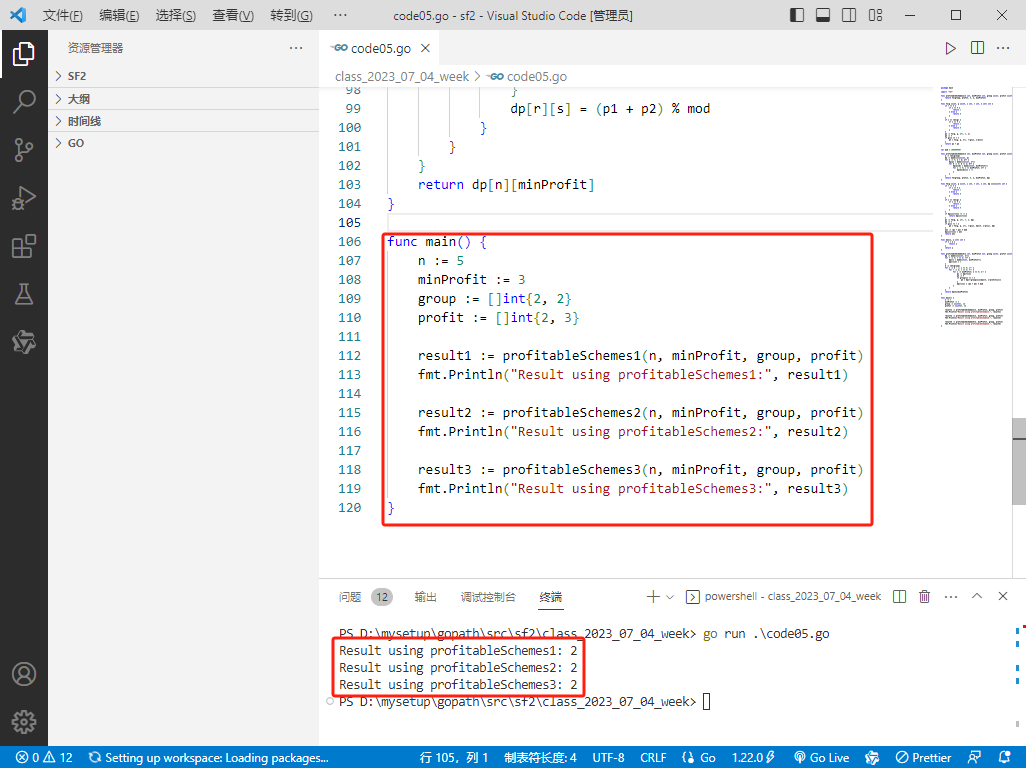2024-03-30:用go语言,集团里有 n 名员工,他们可以完成各种各样的工作创造利润, 第 i 种工作会产生 profit
2024-03-30:用go语言,集团里有 n 名员工,他们可以完成各种各样的工作创造利润, 第 i 种工作会产生 profit

福大大架构师每日一题
发布于 2024-04-11 20:31:05
发布于 2024-04-11 20:31:05
2024-03-30:用go语言,集团里有 n 名员工,他们可以完成各种各样的工作创造利润,
第 i 种工作会产生 profit[i] 的利润,它要求 group[i] 名成员共同参与,
如果成员参与了其中一项工作,就不能参与另一项工作,
工作的任何至少产生 minProfit 利润的子集称为 盈利计划,
并且工作的成员总数最多为 n。
有多少种计划可以选择?因为答案很大,所以 返回结果模 10^9 + 7 的值。
输入:n = 5, minProfit = 3, group = [2,2], profit = [2,3]。
输出:2。
答案2024-03-30:
来自左程云。
灵捷3.5
大体步骤如下:
这三种算法都解决了一个问题,即在给定一组工作和利润以及员工的人数限制下,找出满足最低利润要求的盈利计划数量。以下是它们的大体过程:
profitableSchemes1:
1.递归函数 f1 对组合进行深度优先搜索,尝试每种工作的所有可能性,以达到满足最低利润要求的盈利计划。
2.检查每种工作是否满足人数限制,并计算利润是否达到最低要求。
3.返回满足条件的计划数量。
profitableSchemes2:
1.使用动态规划方法,创建三维数组 dp 以保存中间结果。
2.递归函数 f2 逐步填充 dp 数组,记录以当前工作和利润数为基础时的计划数量。
3.每次计算时检查数组中是否已有记录,避免重复计算。
4.返回最终计划数量。
profitableSchemes3:
1.同样采用动态规划,但只使用二维数组 dp,减少额外空间的使用。
2.从最后一个工作向前逐步计算满足条件的计划数量。
3.根据当前工作是否选择、人数是否足够、利润是否达标,更新动态规划数组中的值。
4.最终输出满足条件的计划数量。
复杂度分析:
- • 时间复杂度:
- • profitableSchemes1: 由于是基于递归的深度优先搜索,时间复杂度较高,为指数级别,取决于工作数量和员工人数。
- • profitableSchemes2: 使用了动态规划并记录了每个可能情况,时间复杂度为 O(m * n * minProfit),m 为工作数量,n 为员工人数。
- • profitableSchemes3: 类似于第二种算法,但只使用了二维数组,时间复杂度也为 O(m * n * minProfit)。
- • 空间复杂度:
- • profitableSchemes1: 仅有递归调用的栈空间,空间复杂度取决于递归深度。
- • profitableSchemes2: 使用了三维数组
dp,空间复杂度为 O(m * n * minProfit)。 - • profitableSchemes3: 使用了二维数组
dp,空间复杂度为 O(n * minProfit)。
Go完整代码如下:
package main
import "fmt"
func profitableSchemes1(n int, minProfit int, group []int, profit []int) int {
return f1(group, profit, 0, n, minProfit)
}
func f1(g []int, p []int, i int, r int, s int) int {
if r <= 0 {
if s <= 0 {
return 1
} else {
return 0
}
}
if i == len(g) {
if s <= 0 {
return 1
} else {
return 0
}
}
p1 := f1(g, p, i+1, r, s)
p2 := 0
if g[i] <= r {
p2 = f1(g, p, i+1, r-g[i], s-p[i])
}
return p1 + p2
}
var mod = 1000000007
func profitableSchemes2(n int, minProfit int, group []int, profit []int) int {
m := len(group)
dp := make([][][]int, m)
for a := 0; a < m; a++ {
dp[a] = make([][]int, n+1)
for b := 0; b <= n; b++ {
dp[a][b] = make([]int, minProfit+1)
for c := 0; c <= minProfit; c++ {
dp[a][b][c] = -1
}
}
}
return f2(group, profit, 0, n, minProfit, dp)
}
func f2(g []int, p []int, i int, r int, s int, dp [][][]int) int {
if r <= 0 {
if s == 0 {
return 1
} else {
return 0
}
}
if i == len(g) {
if s == 0 {
return 1
} else {
return 0
}
}
if dp[i][r][s] != -1 {
return dp[i][r][s]
}
p1 := f2(g, p, i+1, r, s, dp)
p2 := 0
if g[i] <= r {
p2 = f2(g, p, i+1, r-g[i], max(0, s-p[i]), dp)
}
ans := (p1 + p2) % mod
dp[i][r][s] = ans
return ans
}
func max(x, y int) int {
if x > y {
return x
}
return y
}
func profitableSchemes3(n int, minProfit int, group []int, profit []int) int {
dp := make([][]int, n+1)
for r := 0; r <= n; r++ {
dp[r] = make([]int, minProfit+1)
dp[r][0] = 1
}
m := len(group)
for i := m - 1; i >= 0; i-- {
for r := n; r >= 0; r-- {
for s := minProfit; s >= 0; s-- {
p1 := dp[r][s]
p2 := 0
if group[i] <= r {
p2 = dp[r-group[i]][max(0, s-profit[i])]
}
dp[r][s] = (p1 + p2) % mod
}
}
}
return dp[n][minProfit]
}
func main() {
n := 5
minProfit := 3
group := []int{2, 2}
profit := []int{2, 3}
result1 := profitableSchemes1(n, minProfit, group, profit)
fmt.Println("Result using profitableSchemes1:", result1)
result2 := profitableSchemes2(n, minProfit, group, profit)
fmt.Println("Result using profitableSchemes2:", result2)
result3 := profitableSchemes3(n, minProfit, group, profit)
fmt.Println("Result using profitableSchemes3:", result3)
}
本文参与 腾讯云自媒体分享计划,分享自微信公众号。
原始发表:2024-03-30,如有侵权请联系 cloudcommunity@tencent.com 删除
评论
登录后参与评论
推荐阅读
目录